Standardization, Calibration, and Evaluation of Tantalum-Nano rGO-SnO2 Composite as a Possible Candidate Material in Humidity Sensors
Abstract
:1. Introduction
2. Materials and Methods
2.1. Materials
2.2. Preparation of Nano SnO2 and rGO-SnO2 Composites
2.3. Characterization Techniques
2.4. Assembly and Measurement of Humidity Sensors
3. Results and Discussion
3.1. Formation Mechanism of SnO2 and rGO-SnO2 Nanocomposites
3.2. Characterization of Nano SnO2 and rGO-SnO2 Nanocomposites
3.2.1. Fourier Transform Infrared Spectroscopy (FTIR)
3.2.2. X-ray Diffraction (XRD)
3.2.3. Raman Spectra
3.2.4. Transmission Electron Microscope (TEM)
3.3. Humidity Sensing Properties of rGO-SnO2 Sensor
3.4. Humidity Sensors’ Response-Recovery Time
3.5. Sensing Mechanism of rGO-SnO2
4. Conclusions
Acknowledgments
Author Contributions
Conflicts of Interest
References
- Song, X.; Qi, Q.; Zhang, T.; Wang, C. A humidity sensor based on KCl-doped SnO2 nanofibers. Sens. Actuators B Chem. 2009, 138, 368–373. [Google Scholar] [CrossRef]
- Qi, Q.; Zhang, T.; Yu, Q.; Wang, R.; Zeng, Y.; Liu, L.; Yang, H. Properties of humidity sensing ZnO nanorods-base sensor fabricated by screen-printing. Sens. Actuators B Chem. 2008, 133, 638–643. [Google Scholar] [CrossRef]
- Buvailo, A.I.; Xing, Y.; Hines, J.; Dollahon, N.; Borguet, E. TiO2/LiCl-Based nanostructured thin film for humidity sensor applications. ACS Appl. Mater. Interfaces 2011, 3, 528–533. [Google Scholar] [CrossRef] [PubMed]
- Li, G.Y.; Ma, J.; Peng, G.; Chen, W.; Chu, Z.Y.; Li, Y.H.; Hu, T.J.; Li, X.D. Room-temperature humidity-sensing performance of SiC nano paper. ACS Appl. Mater. Interfaces 2014, 6, 22673–22679. [Google Scholar] [CrossRef] [PubMed]
- Qi, Q.; Zhang, T.; Zeng, Y.; Yang, H. Humidity sensing properties of KCl-doped Cu–Zn/CuO–ZnO nanoparticles. Sens. Actuators B Chem. 2009, 137, 21–26. [Google Scholar] [CrossRef]
- Su, P.G.; Huang, L.N. Humidity sensors based on TiO2 nanoparticles/polypyrrole composite thin films. Sens. Actuators B Chem. 2007, 123, 501–507. [Google Scholar] [CrossRef]
- Faia, P.M.; Emanuel, L.J.; Louro, C.S. TiO2:WO3 composite humidity sensors doped with ZnO and CuO investigated by impedance spectroscopy. Sens. Actuators B Chem. 2014, 203, 340–348. [Google Scholar] [CrossRef]
- Zainelabdin, A.; Amin, G.; Zaman, S.; Nur, O.; Lu, J.; Hultman, L.; Willander, M. CuO/ZnO nanocorals synthesis via hydrothermal technique: growth mechanism and their application as humidity sensor. J. Mater. Chem. 2012, 22, 11583–11590. [Google Scholar] [CrossRef]
- Parthibavarman, M.; Hariharan, V.; Sekar, C. High-sensitivity humidity sensor based on SnO2 nanoparticles synthesized by microwave irradiation method. Mater. Sci. Eng. 2011, 31, 840–844. [Google Scholar] [CrossRef]
- Fei, T.; Jiang, K.; Liu, S.; Zhang, T. Humidity sensor based on a cross-linked porous polymer with unexpectedly good properties. RSC Adv. 2014, 4, 21429–21434. [Google Scholar] [CrossRef]
- Yu, H.W.; Kim, H.K.; Kim, T.; Bae, K.M.; Seo, S.M.; Kim, J.M.; Kang, T.J.; Kim, Y.H. Self-Powered humidity sensor based on graphene oxide composite film intercalated by Poly(Sodium 4-Styrenesulfonate). ACS Appl. Mater. Interfaces 2014, 4, 8320–8326. [Google Scholar] [CrossRef] [PubMed]
- Chi, H.; Liu, Y.J.; Wang, F.; He, C. Highly sensitive and fast response colorimetric humidity sensors based on graphene oxides film. ACS Appl. Mater. Interfaces 2015, 7, 19882–19886. [Google Scholar] [CrossRef] [PubMed]
- Seema, H.; Kemp, K.C.; Chandra, V.; Kim, K.S. Graphene-SnO2 composites for highly efficient photocatalytic degradation of methylene blue under sunlight. Nanotechnology 2012, 23, 355705–355713. [Google Scholar] [CrossRef] [PubMed]
- Zhang, H.; Feng, J.; Fei, T.; Liu, S.; Zhang, T. SnO2 nanoparticles-reduced graphene oxide nanocomposites for NO2 sensing at low operating temperature. Sens. Actuators B Chem. 2014, 190, 472–478. [Google Scholar] [CrossRef]
- Masatsugu, M.; Yasutaka, O.; Sachiyo, S.; Morio, M. Effects of surface modification with platinum and ruthenium on temperature and humidity dependence of SnO2-based CO gas sensors. Sens. Actuators B Chem. 2000, 67, 84–188. [Google Scholar]
- Liu, L.L.; Xu, J.; Lu, X.; Munroe, P.; Xie, Z.H. Electrochemical corrosion behavior of nano crystalline β-Ta coating for biomedical applications. ACS Biomater. Sci. Eng. 2016, 2, 579–594. [Google Scholar] [CrossRef]
- Hummers, W.S.; Offeman, R.E. Preparation of graphitic oxide. J. Am. Chem. Soc. 1958, 80, 1339. [Google Scholar] [CrossRef]
- Kovtyukhova, N.I.; Ollivier, P.J.; Martin, B.R.; Mallouk, T.E.; Chizhik, S.A.; Buzaneva, E.V.; Gorchinskiy, A.D. Layer-by-layer assembly of ultrathin composite films from micron sized graphite oxide sheets and polycations. Chem. Mater. 1999, 11, 771–778. [Google Scholar] [CrossRef]
- Li, X.Z.; Liu, S.R.; Ying, G. Polyaniline-intercalated layered double hydroxides: synthesis and properties for humidity sensing. RSC Adv. 2016, 6, 63099–63106. [Google Scholar] [CrossRef]
- Li, F.H.; Song, J.F.; Yang, H.F.; Gan, S.Y.; Zhang, Q.X.; Han, D.X.; Ivaska, A.; Niu, L. One-step synthesis of graphene/SnO2 nanocomposites and its application in electrochemical supercapacitors. Nanotechnology 2009, 20, 455602–455607. [Google Scholar] [CrossRef] [PubMed]
- Dubin, S.; Gilje, S.; Wang, K.; Tung, V.C.; Cha, K.; Hall, A.S.; Farrar, J.; Varshneya, R.; Yang, Y.; Kaner, R.B. A one-step, solvothermal reduction method for producing reduced graphene oxide dispersions in organic solvents. ACS Nano 2010, 4, 3845–3852. [Google Scholar] [CrossRef] [PubMed]
- Paek, S.M.; Yoo, E.; Honma, I. Enhanced cyclic performance and lithium storage capacity of SnO2/graphene nano porous electrodes with three-dimensionally delaminated flexible structure. Nano Lett. 2009, 9, 72–75. [Google Scholar] [CrossRef] [PubMed]
- Kar, A.; Sain, S.; Rossouw, D.; Knappett, B.R.; Pradhanb, S.K.; Wheatley, A.E.H. Facile synthesis of SnO2-PbS nanocomposites with controlled structure for applications in photocatalysis. Nanoscale 2016, 8, 2727–2739. [Google Scholar] [CrossRef] [PubMed]
- Lee, B.; Han, S.C.; Oh, M.; Lah, M.S.; Sohn, K.S.; Pyo, M. Tin dioxide nanoparticles impregnated in graphite oxide for improved lithium storage and cyclability in secondary ion batteries. Electrochim. Acta 2013, 113, 149–155. [Google Scholar] [CrossRef]
- Du, F.; Yang, B.; Zuo, X.; Li, G. Dye-sensitized solar cells based on low-cost nanoscale SnO2@RGO composite counter electrode. Mater. Lett. 2015, 158, 424–427. [Google Scholar] [CrossRef]
- Hu, C.; Chen, F.; Lu, T.; Lian, C.; Zheng, S.; Zhang, R. Aqueous production of TiO2-graphene nanocomposites by a combination of electrostatic attraction and hydrothermal process. Mater. Lett. 2014, 121, 209–211. [Google Scholar] [CrossRef]
- Prabakar, S.J.R.; Hwang, Y.H.; Bae, E.G.; Shim, S.; Kim, D.; Lah, M.S.; Sohn, K.S.; Pyo, M. SnO2/graphene composites with self-assembled alternating oxide and amine layers for high Li-storage and excellent stability. Adv. Mater. 2013, 25, 3307–3312. [Google Scholar] [CrossRef] [PubMed]
- Kuse, T.; Takahashi, S. Transitional behavior of tin oxide semiconductor under a step-like humidity change. Sens. Actuators B Chem. 2000, 67, 36–42. [Google Scholar] [CrossRef]
- Tripathy, A.; Pramanik, S.; Cho, J.; Santhosh, J.; Abu Osman, N.A. Role of morphological structure doping and coating of different materials in the sensing characteristics of humidity sensors. Sensors 2014, 14, 16343–16422. [Google Scholar] [CrossRef] [PubMed]
- Bondarenka, V.; Grebinskij, S.; Mickevcius, S.; Volkov, V.; Zacharova, G. Thin films of poly-vanadium-molybdenum acid as starting materials for humidity sensors. Sens. Actuators B Chem. 1995, 28, 227–231. [Google Scholar] [CrossRef]
- Feng, Y.; Wang, S.; Feng, B.; Wang, R.; He, Y.; Zhang, T. Development of an auto test system for humidity sensors. Sens. Actuators A Phys. 2009, 152, 104–109. [Google Scholar] [CrossRef]
- Bi, H.; Yin, K.; Xie, X.; Wan, S.; Ji, J.; Sun, L.; Terrones, M.; Dresselhaus, M.S. Ultrahigh humidity sensitivity of graphene oxide. Sci. Rep. 2013, 3, 2714. [Google Scholar] [CrossRef] [PubMed]
- Cheng, B.H.; Tian, B.X.; Xie, C.C.; Xiao, Y.H.; Lei, S.J. Highly sensitive humidity sensor based on amorphous Al2O3 nanotubes. J. Mater. Chem. 2011, 21, 1907–1912. [Google Scholar] [CrossRef]
- Wang, W.C.; Tian, Y.T.; Li, K.; Lu, E.Y.; Gong, D.S.; Li, X.J. Capacitive humidity-sensing properties of Zn2SiO4 film grown on silicon nano porous pillar array. Appl. Surface Sci. 2013, 273, 372–376. [Google Scholar] [CrossRef]
- Tripathy, A.; Pramanik, S.; Manna, A.; Bhuyan, S.; Azrin Shah, N.F.; Azuan Abu Osman, Z.R.N. Design and development for capacitive humidity sensor applications of Lead-Free Ca,Mg,Fe,Ti-Oxides-based electro-ceramics with improved sensing properties via physisorption. Sensors 2016, 16, 1135. [Google Scholar] [CrossRef] [PubMed]
- Zhang, Z.; Huang, J.; Yuan, Q.; Dong, B. Intercalated graphitic carbon nitride: A fascinating two-dimensional nanomaterial for an ultrasensitive humidity nano sensor. Nanoscale 2014, 6, 9250–9256. [Google Scholar] [CrossRef] [PubMed]
- Chu, J.; Peng, X.; Feng, P.; Sheng, Y.; Zhang, J. Study of humidity sensors based on nanostructured carbon films produced by physical vapor deposition. Sens. Actuators B Chem. 2013, 178, 508–513. [Google Scholar] [CrossRef]
- Li, L.; Yu, K.; Wu, J.; Wang, Y.; Zhu, Z. Structure and humidity sensing properties of SnO2 zigzag belts. Cryst. Res. Technol. 2010, 45, 539–544. [Google Scholar] [CrossRef]
- Kuang, Q.; Lao, C.; Wang, Z.L.; Xie, Z.; Zheng, L. High-sensitivity humidity sensor based on a single SnO2 nanowire. J. Am. Chem. Soc. 2007, 129, 6070–6071. [Google Scholar] [CrossRef] [PubMed]
- Md Sin, N.D.; Mamat, M.H.; Malek, M.F.; Rusop, M. Fabrication of nano cubic ZnO/SnO2 film-based humidity sensor with high sensitivity by ultrasonic-assisted solution growth method at different Zn:Sn precursor ratios. Appl. Nanosci. 2014, 4, 829–838. [Google Scholar] [CrossRef]
- Zhang, Y.; Yu, K.; Jiang, D.; Zhu, Z.; Geng, H.; Luo, L. Zinc oxide nanorod and nanowire for humidity sensor. Appl. Surf. Sci. 2005, 242, 212–217. [Google Scholar] [CrossRef]
- Chen, W.P.; Zhao, Z.G.; Liu, X.W.; Zhang, Z.X.; Suo, C.G. A Capacitive Humidity Sensor Based on Multi-Wall Carbon Nanotubes (MWCNTs). Sensors 2009, 9, 7431–7444. [Google Scholar] [CrossRef] [PubMed]
- Chen, X.; Zhang, J.; Wang, Z.; Yan, Q.; Hui, S. Humidity sensing behavior of silicon nanowires with hexamethyldisilazane modification. Sen. Actuators B Chem. 2011, 156, 631–636. [Google Scholar] [CrossRef]
- Wang, Y.; Park, S.; Yeow, J.T.W.; Langner, A.; Müller, F. A capacitive humidity sensor based on ordered macro porous silicon with thin film surface coating. Sens. Actuators B Chem. 2010, 49, 136–142. [Google Scholar] [CrossRef]
- Wang, Z.; Shi, L.; Wu, F.; Yuan, S.; Zhao, Y.; Zhang, M. The sol-gel template synthesis of porous TiO2 for a high performance humidity sensor. Nanotechnology 2011, 22, 275502–275511. [Google Scholar] [CrossRef] [PubMed]
- Sun, A.; Li, Z.; Wei, T.; Li, Y.; Cui, P. Highly sensitive humidity sensor at low humidity based on the quaternized polypyrrole composite film. Sens. Actuators B Chem. 2009, 142, 197–203. [Google Scholar] [CrossRef]
- Henrich, V.A.; Cox, P.A. The Surface Science of Metal Oxides; Cambridge University Press: Cambridge, UK, 1994; p. 312. [Google Scholar]
- Cosentino, I.C.; Muccillo, E.N.S.; Muccillo, R. The Influence of Fe2O3 in the humidity sensor performance of ZrO2:TiO2-based porous ceramics. Mater. Chem. Phys. 2007, 103, 407–414. [Google Scholar] [CrossRef]
- Singh, R.; Yadav, A.K.; Gautam, C. Synthesis and humidity sensing investigations of nanostructured ZnSnO3. J. Sens. Technol. 2011, 1, 116–124. [Google Scholar] [CrossRef]
- Kang, D.; Liu, Q.; Chen, M.; Gu, J.; Zhang, D. Spontaneous cross-linking for fabrication of nano hybrids embedded with size-controllable particles. ACS Nano 2016, 10, 889–898. [Google Scholar] [CrossRef] [PubMed]
- Md Sin, N.D.; Mamat, M.H.; Musa, M.Z.; Abdul Aziz, A.; Rusop, M. Effect of growth duration to the electrical properties of Zn doped SnO2 thin film toward humidity sensor application. In Proceedings of the 2012 IEEE Business, Engineering & Industrial Applications Colloquium (BEIAC), Kuala Lumpur, Malaysia, 7–8 April 2012.
- Xu, L.; Wang, R.; Xiao, Q.; Zhang, D.; Liu, Y. Micro humidity sensor with high sensitivity and quick response/recovery based on ZnO/TiO2 composite nanofibers. Chin. Phys. Lett. 2011, 28, 070702. [Google Scholar] [CrossRef]
- Farahani, H.; Wagiran, R.; Hamidon, M.N. Humidity sensors principle, mechanism and fabrication technologies: A comprehensive review. Sensors 2014, 14, 7881–7939. [Google Scholar] [CrossRef] [PubMed]
- Chen, Z.; Lu, C. Humidity sensors: A review of materials and mechanisms. Sens. Lett. 2005, 3, 274–295. [Google Scholar] [CrossRef]
- Zhang, D.; Sun, Y.; Li, P.; Zhang, Y. Facile fabrication of MoS2-modified SnO2 hybrid nanocomposite for ultrasensitive humidity sensing. ACS Appl. Mater. Interfaces 2016, 8, 14142–14149. [Google Scholar] [CrossRef] [PubMed]
- Lin, Q.; Li, Y.; Yang, M. Tin oxide/graphene composite fabricated via a hydrothermal method for gas sensors working at room temperature. Sens. Actuators B Chem. 2012, 173, 139–147. [Google Scholar] [CrossRef]
- Tammanoon, N.; Wisitsoraat, A.; Sriprachuabwong, C.; Phokharatkul, D.; Tuantranont, A.; Phanichphant, S.; Liewhiran, C. Ultrasensitive NO2 sensor based on ohmic metal-semiconductor interfaces of electrolytically exfoliated graphene/flame-spray-made SnO2 nanoparticles composite operating at low temperatures. ACS Appl. Mater. Interfaces 2015, 7, 24338–24352. [Google Scholar] [CrossRef] [PubMed]
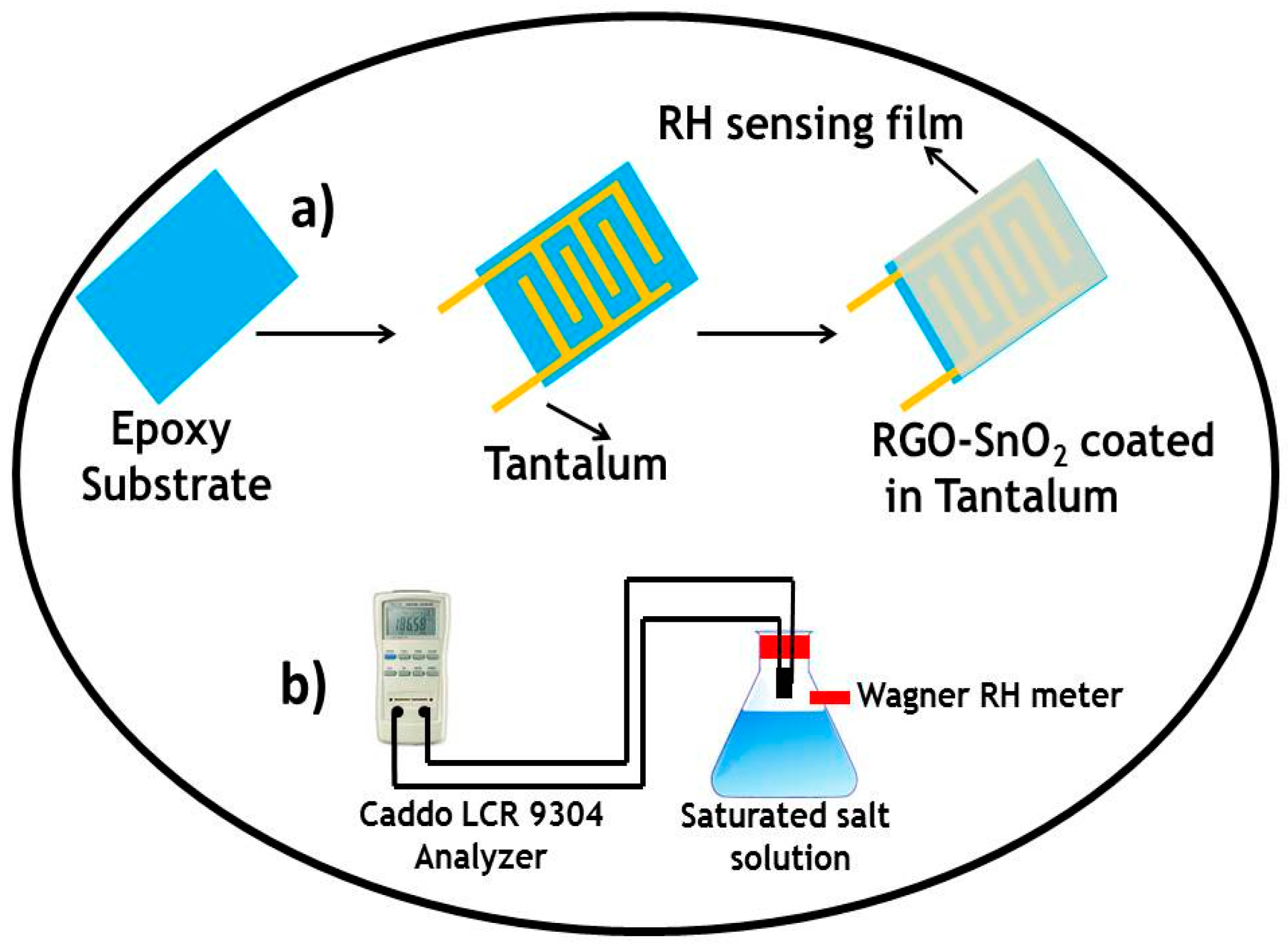
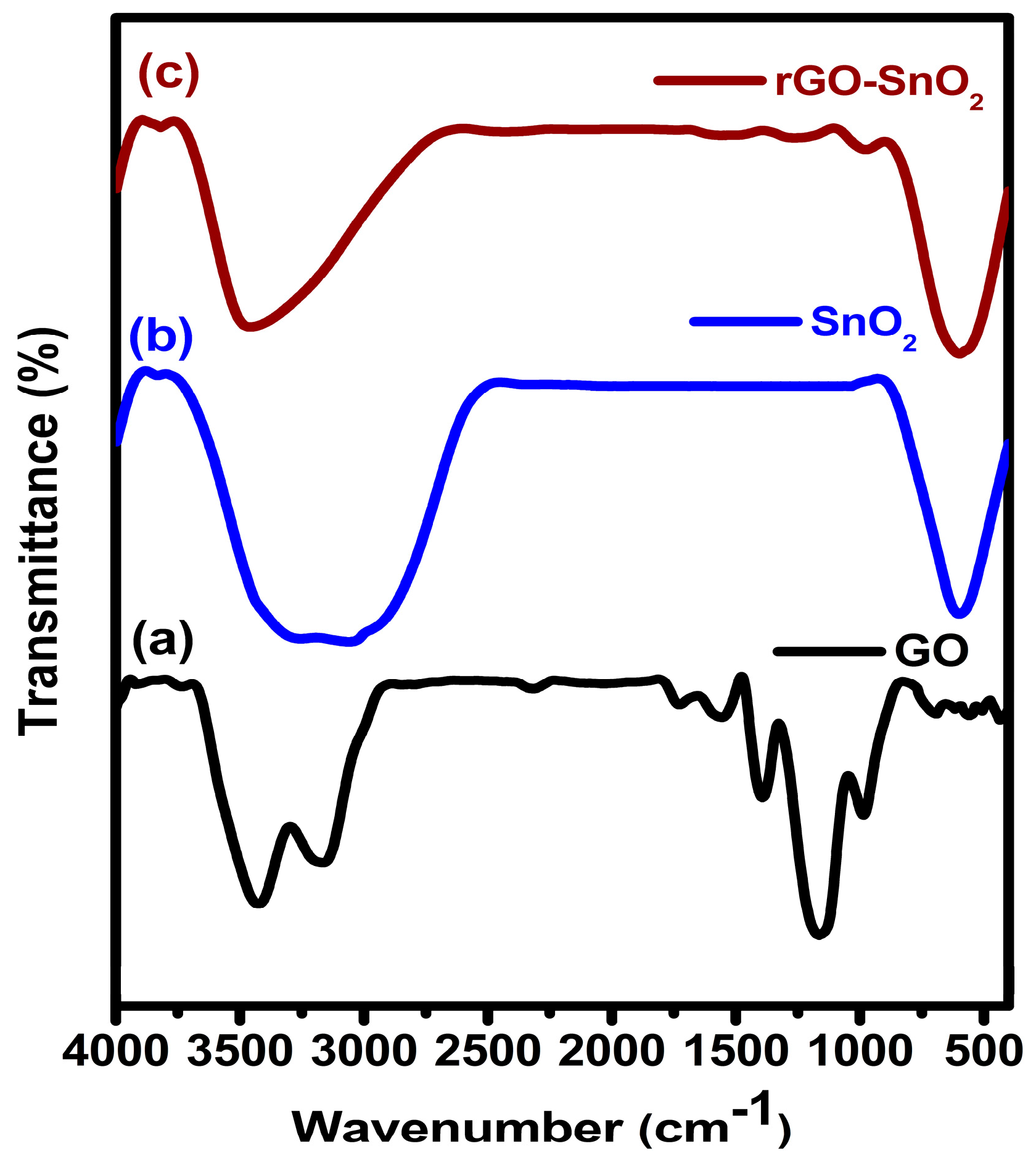
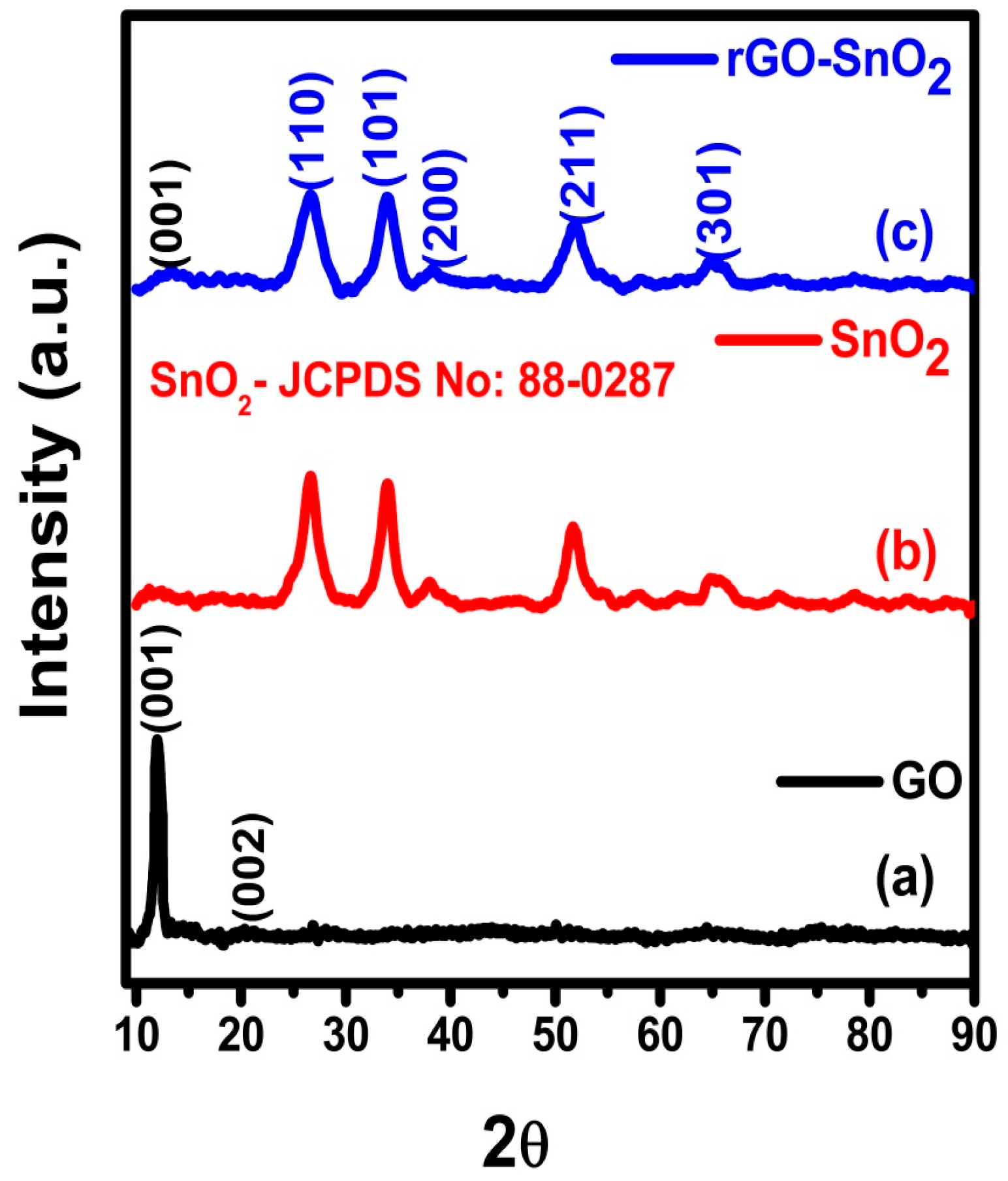
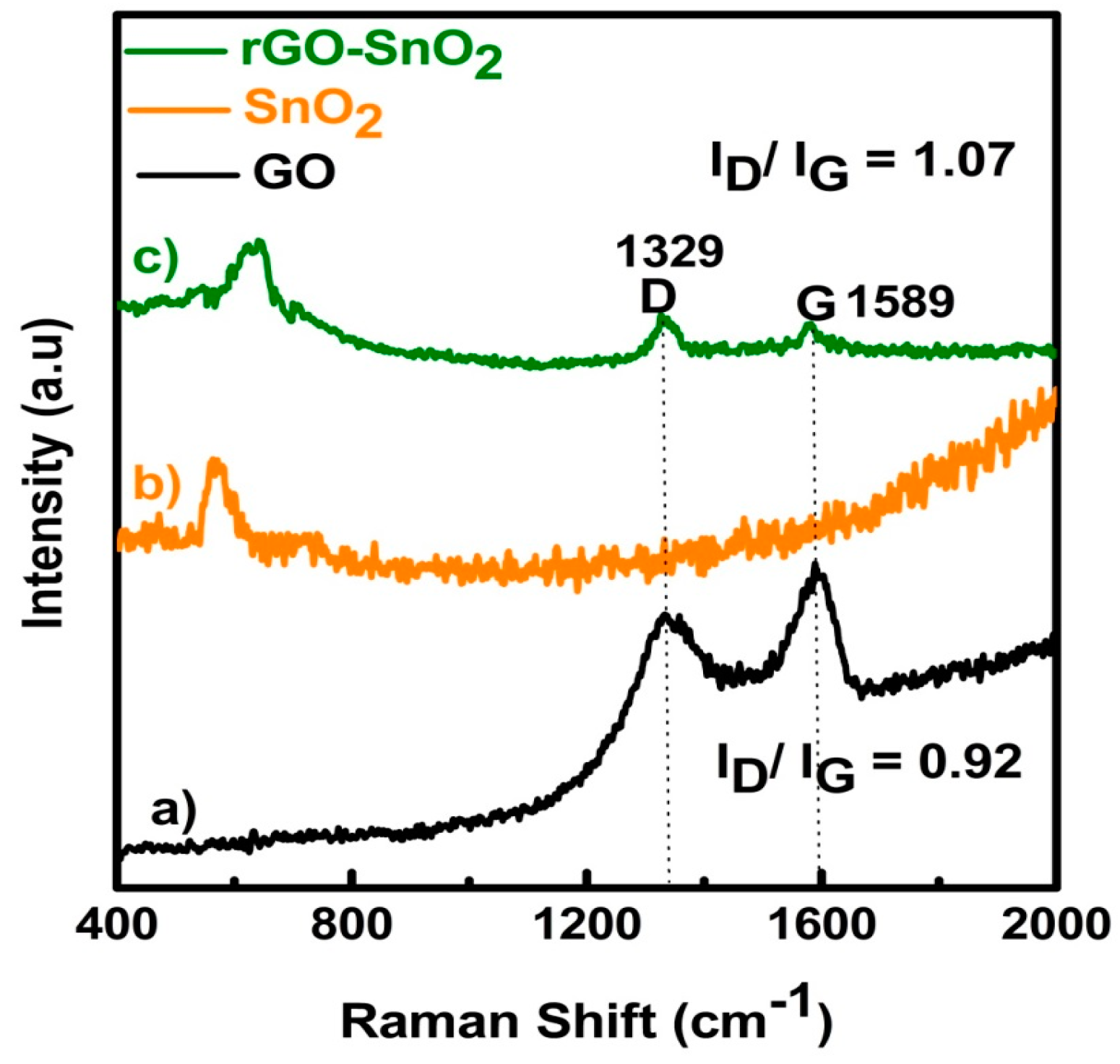

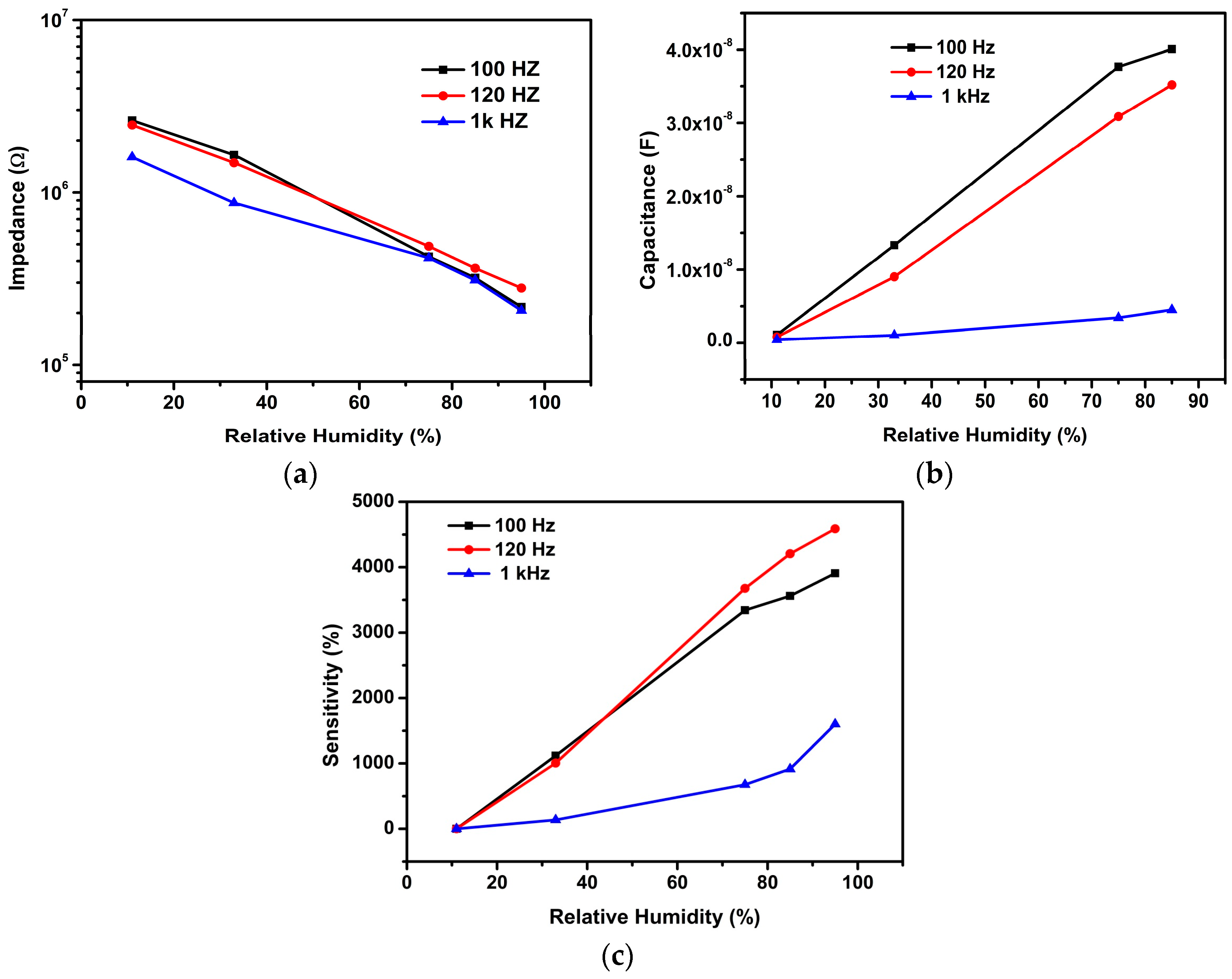
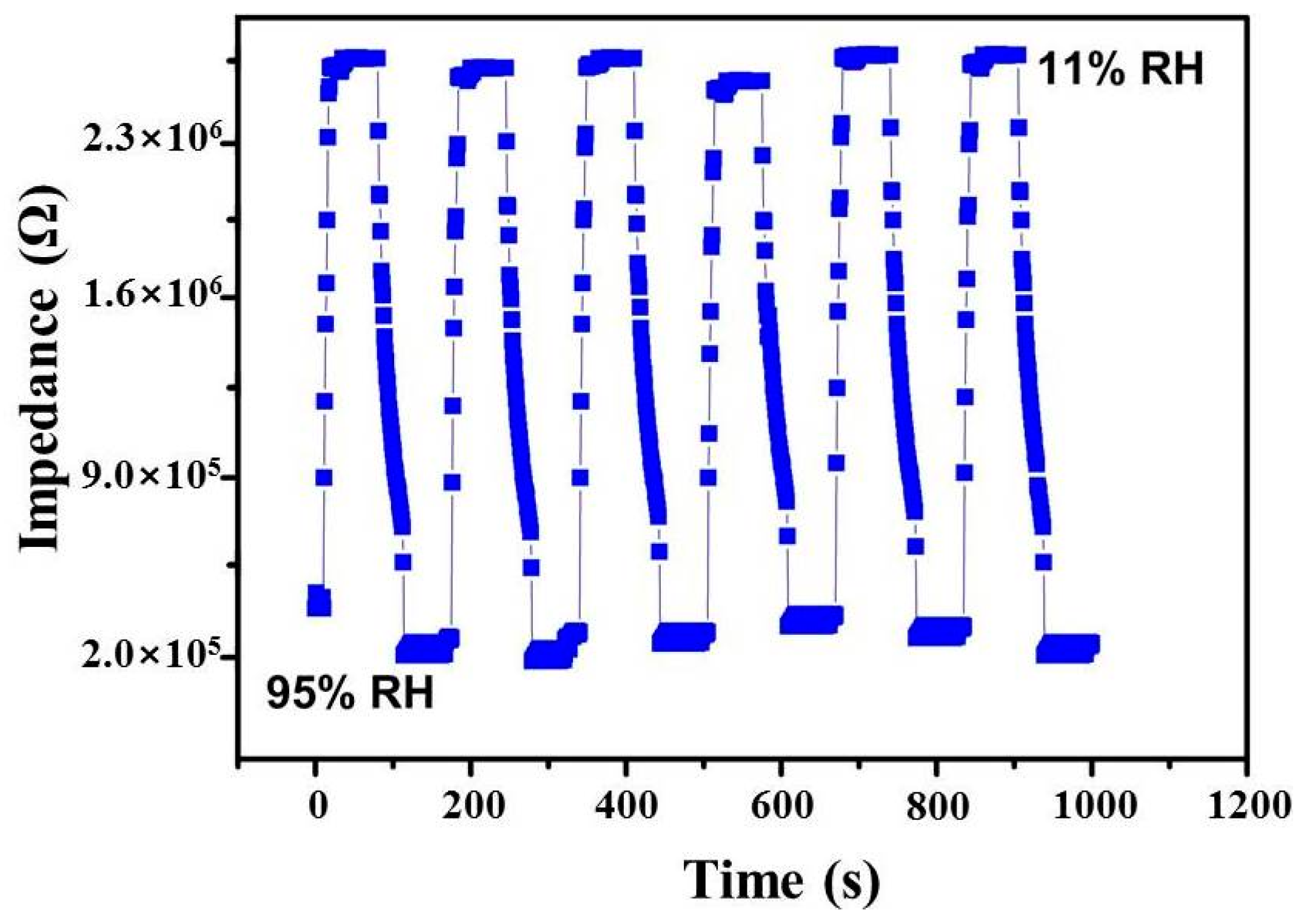
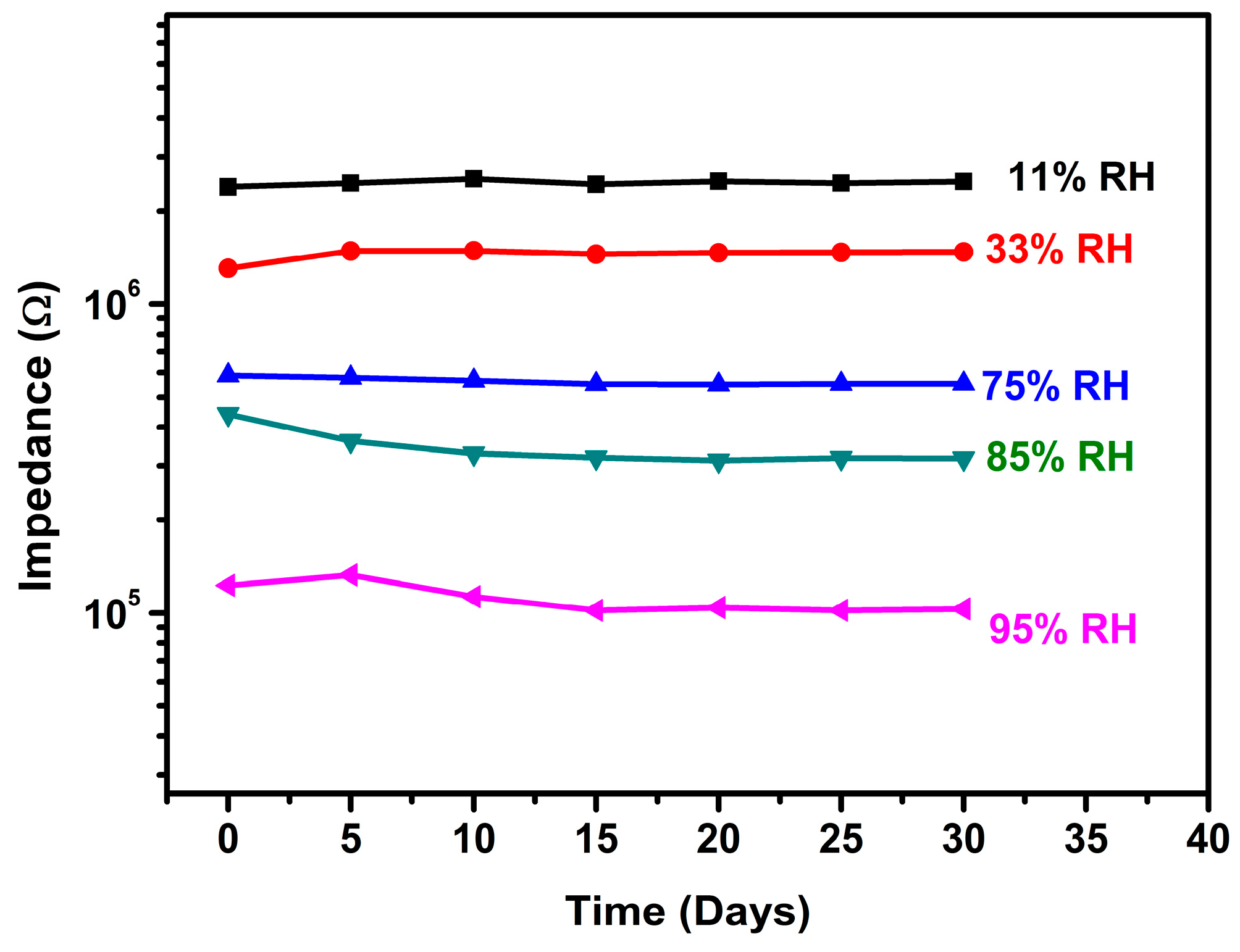
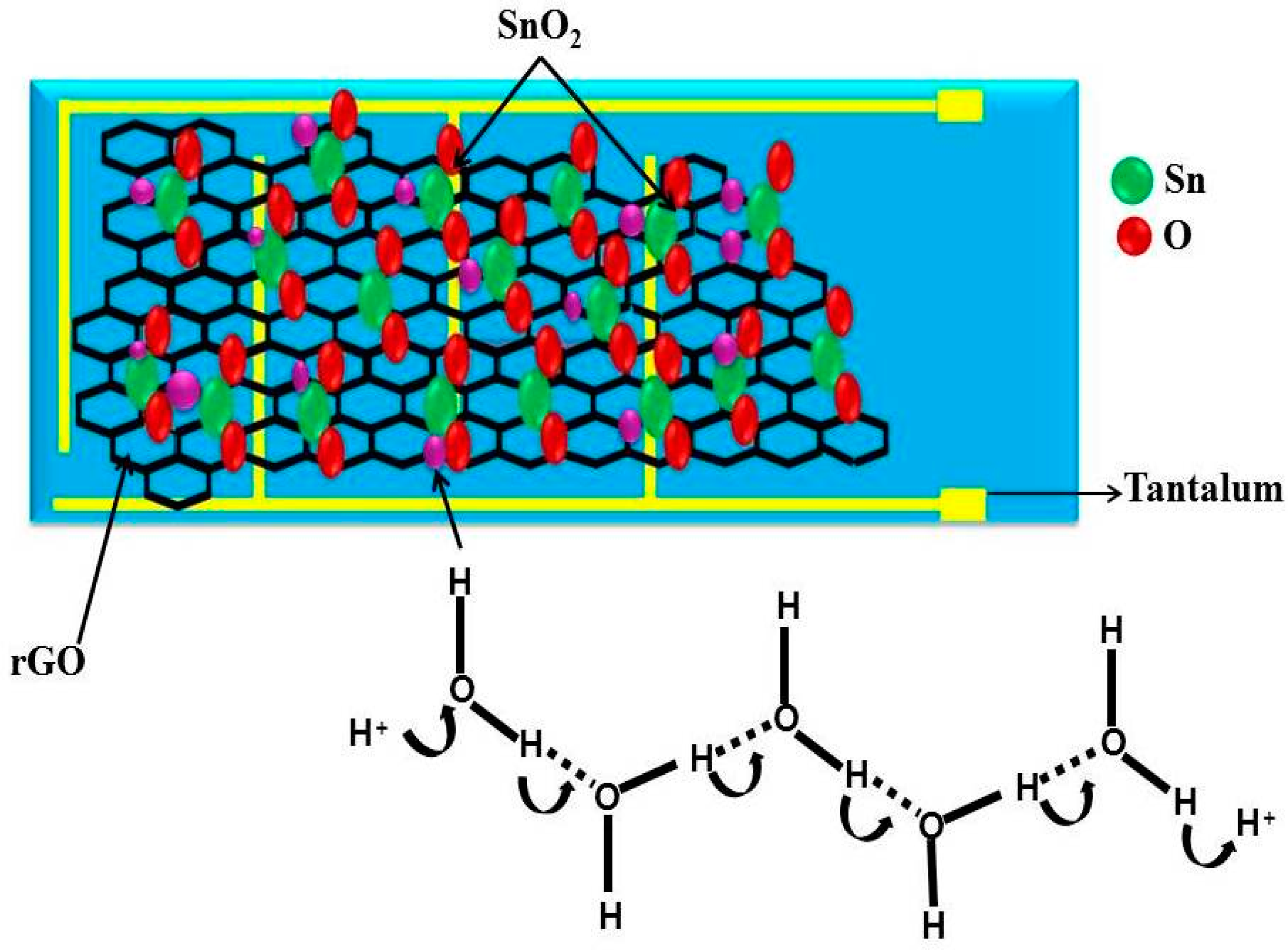
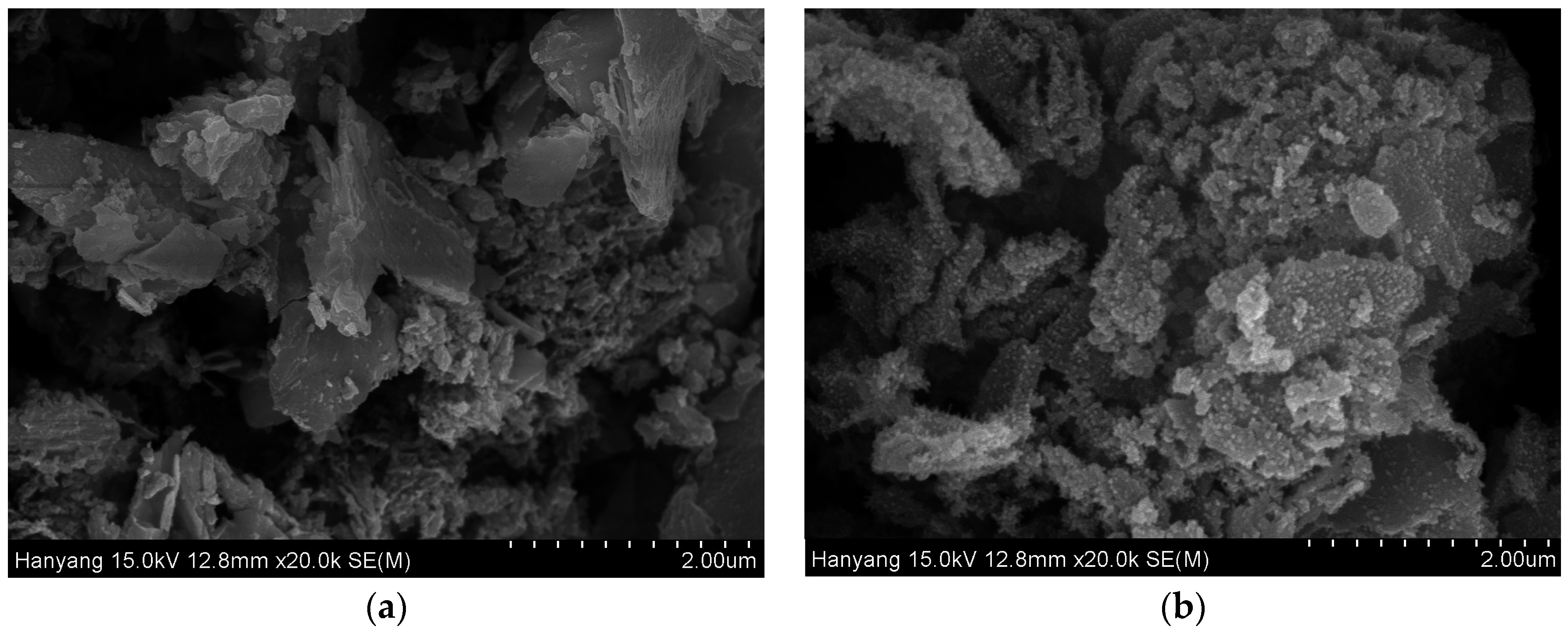
| Reference | Electrode | Substrate | Sensing Material | Sensor Response Time (s) | Sensor Recovery Time (s) |
|---|---|---|---|---|---|
| Bi et al. [32] | Gold (Au) | SiO2 | Graphene oxide | 10.5 | 41 |
| Li et al. [38] | Sliver (Ag) | SiO2 | SnO2 | 30–110 | 80–150 |
| Kuang et al. [39] | Platinum (Pt) | SiO2 | SnO2 | 120–170 | 20–60 |
| Sin et al. [40] | Gold (Au) | SiO2 | ZnO/SnO2 | 411 | 98 |
| Zhang et al. [41] | Platinum (Pt) | SiO2 | ZnO | 10 | 30 |
| Chen [42] | Copper (Cu) | SiO2 | MWCNTs | 45 | 15 |
| Chen et al. [43] | Silver (Ag) | Si | SiNWs | 350 | 52 |
| Chen et al. [43] | Silver (Ag) | Si | HMDS modified SiNWs | 132 | 62 |
| Wang et al. [44] | Porous Silicon | Si | Ta2O5 | 18 | 40 |
| Wang et al. [45] | Silver (Ag) | Ceramic | TiO2 | 5 | 10 |
| Sun et al. [46] | Gold electrode | Aluminum | Polypyrrole | 41 | 120 |
| Proposed differentiate | Tantalum electrode | Epoxy | rGO-SnO2 | 10 | 60 |
© 2016 by the authors; licensee MDPI, Basel, Switzerland. This article is an open access article distributed under the terms and conditions of the Creative Commons Attribution (CC-BY) license (http://creativecommons.org/licenses/by/4.0/).
Share and Cite
Karthick, S.; Lee, H.-S.; Kwon, S.-J.; Natarajan, R.; Saraswathy, V. Standardization, Calibration, and Evaluation of Tantalum-Nano rGO-SnO2 Composite as a Possible Candidate Material in Humidity Sensors. Sensors 2016, 16, 2079. https://doi.org/10.3390/s16122079
Karthick S, Lee H-S, Kwon S-J, Natarajan R, Saraswathy V. Standardization, Calibration, and Evaluation of Tantalum-Nano rGO-SnO2 Composite as a Possible Candidate Material in Humidity Sensors. Sensors. 2016; 16(12):2079. https://doi.org/10.3390/s16122079
Chicago/Turabian StyleKarthick, Subbiah, Han-Seung Lee, Seung-Jun Kwon, Rethinam Natarajan, and Velu Saraswathy. 2016. "Standardization, Calibration, and Evaluation of Tantalum-Nano rGO-SnO2 Composite as a Possible Candidate Material in Humidity Sensors" Sensors 16, no. 12: 2079. https://doi.org/10.3390/s16122079
APA StyleKarthick, S., Lee, H.-S., Kwon, S.-J., Natarajan, R., & Saraswathy, V. (2016). Standardization, Calibration, and Evaluation of Tantalum-Nano rGO-SnO2 Composite as a Possible Candidate Material in Humidity Sensors. Sensors, 16(12), 2079. https://doi.org/10.3390/s16122079







